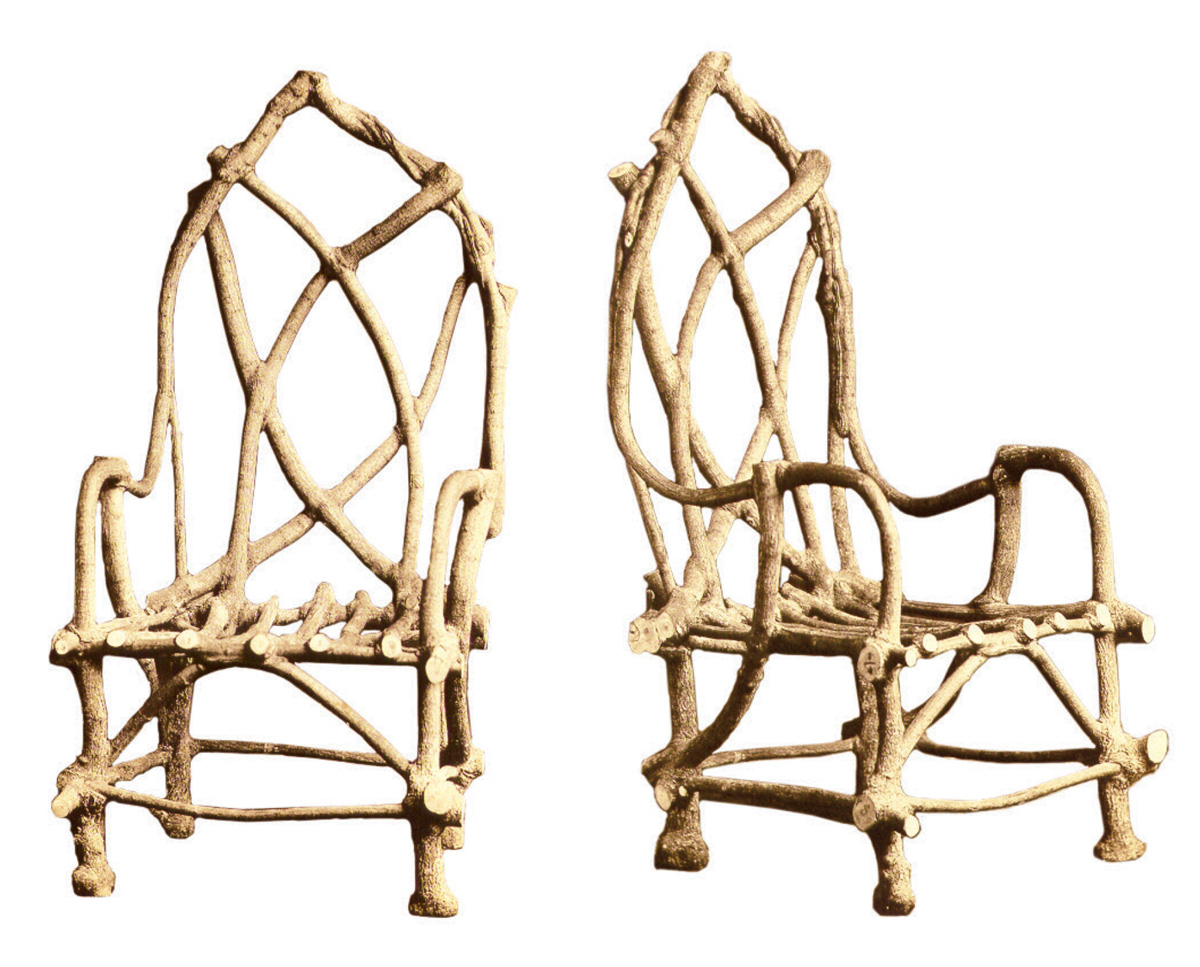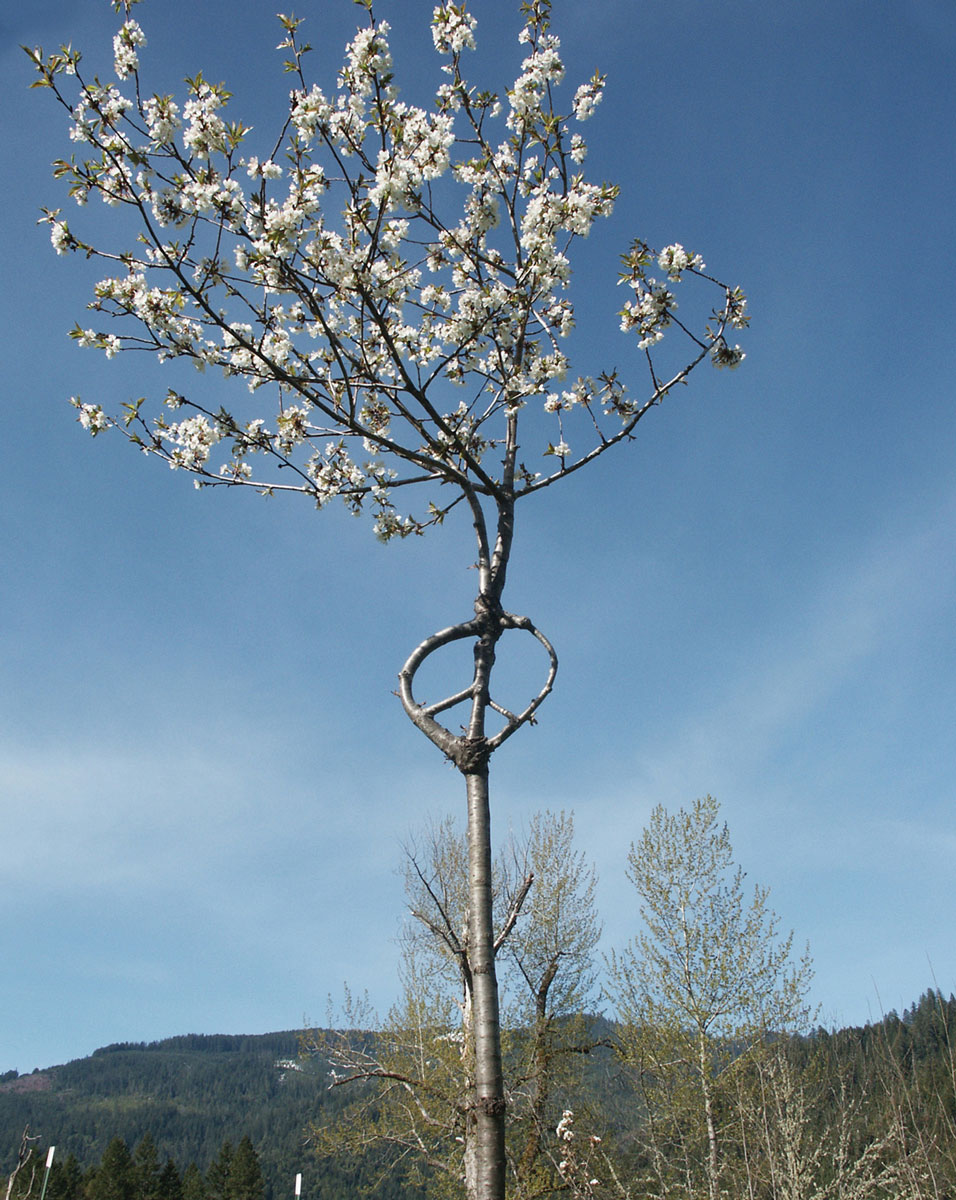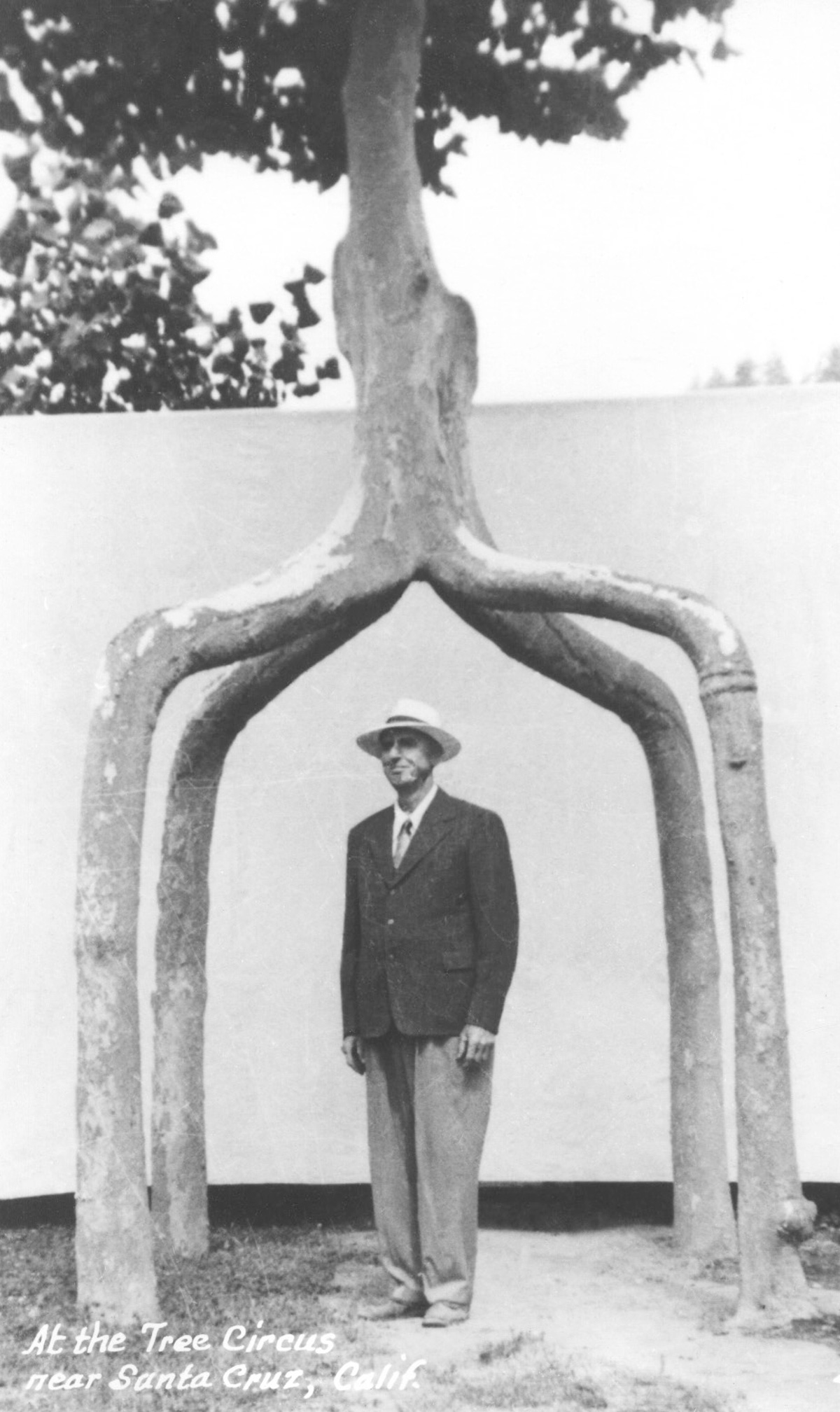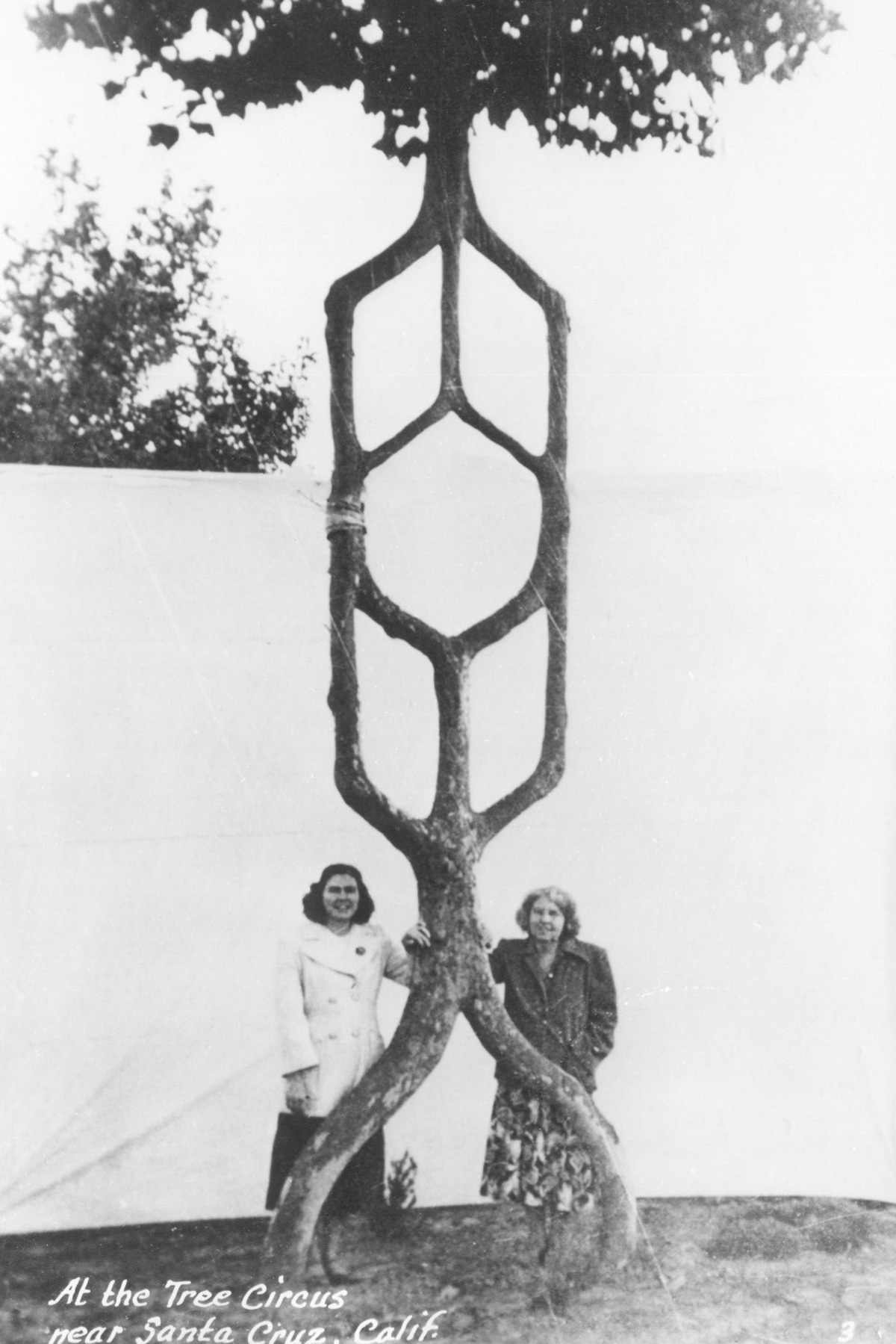How to Grow a Chair: An Interview with Richard Reames
The roots of arborsculpture
Joshua Foer and Richard Reames

Using ancient grafting techniques and a few basic tools, Richard Reames shapes living trees into furniture and sculpture near his home in Oregon for clients worldwide. He is the author of two self-published books, How to Grow a Chair: The Art of Tree Trunk Topiary with Barbara Delbol, and Arborsculpture: Solutions for a Small Planet, published in June. His work was on display this summer at the World Expo in Aichi, Japan. Joshua Foer spoke to Reames in July 2005 by telephone.

Joshua Foer: How does arborsculpture differ from bonsai or topiary?
Richard Reames: Arborsculpture is the art of shaping tree trunks to create art and functional items through bending, grafting, pruning, and multiple planting. Bonsai is the art of miniaturizing trees. Some of bonsas basic techniques, such as bending branches and pruning, are similar to arborsculpture. Topiary was originally defined as ornamental gardening, so you could say, to be technical, that arborsculpture is a branch of topiary, but the word topiary is more commonly used to describe the shaping of foliage. In that sense, topiary is almost the opposite of arborsculpture in that you’re only trimming the foliage, whereas in arborsculpture, you’re only working with the trunk. Of the various tree arts, arborsculpture is most closely related to espalier, a technique that began in France as a way to grow quality fruit in small areas, like inside castle courtyards. They’d grow fruit trees up against the wall and shape the branches so that they were evenly spaced and parallel, maximizing the amount of fresh air to each piece of fruit. I like to say that arborsculpture is like espalier on acid.
Tell me about some of the arborsculptures you’ve grown.
I have grown many chairs and benches. I have a 30-foot spiral poplar tree that goes up 8 feet, splits into two trunks that spiral around each other, and then is grafted back together at about 16 feet high. I have a nice spiral staircase growing right now in oak. I planted a circle of birch trees years ago and just recently spun them all clockwise a few feet and grafted the tops together. It’s a small gazebo.
Can you walk me through how you’d grow a chair?
For a chair, I select perhaps a dozen flexible, long, unbranched saplings and I plant them in a pattern. I can then bend them along a frame into the shape of a chair or a bench and do the initial grafting. The majority of the work can be done all at once. The frame holds the trees for a few years until the tree casts that form through its growth. It’s just a matter of the trees getting older and growing together with some gentle pruning to keep them growing in the right direction.
You’re also trying to grow a boat.
That’s a collaboration with a friend. We planted two very long ash trees that arch up at the ends. They form the bottom of the boat. Then we planted rib trees so that the planking can be fastened on. That project is intended to be harvested once it’s thick enough. At first we projected it would take five years, but I’m guessing it’ll be more like eight.
While the boat may be functional, much of what you grow is purely sculptural. What are the aesthetic criteria by which an arborsculpture is judged?
I think balance is the number one criterion. Learning how to create symmetrical growth is the key to creating a good arborsculpture. Say you’re going to use four trees; if you can get them to grow at the same rate, then you have even balance. To achieve even growth, you either have to limit the fast-growing trees or speed up the slower-growing ones. Also critical is the way the grafts heal. That’s where the true mystery and power of this art lies.
Given that arborsculpture requires only the most primitive tools, it seems like it should have been invented a long time ago. Why wasn’t it?
That’s a question I often wonder about. Perhaps the Druids were great tree-shapers, but since wood doesn’t preserve well, the evidence may have rotted long ago. Even though arborsculpture didn’t have a name until I coined the term in 1995, there are historical examples of tree-shaping. The oldest evidence we have is a five-by-seven inch illumination from 1516 by Jean Perréal, titled Nature Objects to the Alchemist’s Errors. In the painting, an angel is sitting in an elaborately shaped, grafted tree. She has folded arms and is chastising the alchemist, who does not look pleased. Perréal’s illumination accompanied a new version of Roman de la Rose, an allegory of chivalric love that is considered one of the greatest literary works of the thirteenth century.
Tell me about some of the early practitioners of arborsculpture.
In one of his books, Earths in the Universe, the Swedish mystic Emanuel Swedenborg wrote about visiting another planet whose inhabitants dwelled in living trees. He talked about how they would shape these trees from a very young stage and guide their growth into temples. Later, a nineteenth-century Austrian mystic named Jakob Lorber wrote a book called The Household of God about the wisdom of planting trees in a circle. Once they had grown together, Lorber said, the ring of trees would be a much better house than anything anyone could build.

Did Swedenborg or Lorber ever grow an arborsculpture?
No, they didn’t. There were three modern pioneers of arborsculpture: John Krubsack, Arthur Wiechula, and Axel Erlandson. Krubsack was a prominent banker in the small town of Embarrass, Wisconsin, at the turn of the last century. He grew an extraordinary chair out of box elder that was shown at the 1915 World’s Fair. In 1926, Wiechula, a German agricultural engineer, published a radical little book called Developing Houses from Living Trees. Wiechula never successfully grew a living house, but he did grow a 394-foot-long wall structure using Canadian poplars to keep snowdrifts off a section of train tracks.
But no other figure went so far in demonstrating the tree’s potential as Erlandson. In 1947, he created a roadside attraction in Scott’s Valley, California, called the Tree Circus. It was advertised with a large sign that said simply, “SEE THE WORLD’S STRANGEST TREES HERE.” He shaped about seventy-five trees and invited the public in for a fee. He never was very successful on the business end of things, but his trees were stunning and unique.
How did Erlandson get started?
In nature, it’s not uncommon that two trees will lean up against each other and self-graft. It’s called an inosculation. Erlandson found one in a hedgerow on his farm. He realized he could do that intentionally and form any kind of structure he wished.
Did Erlandson know about Krubsack and Wiechula?
There’s no evidence that he did, but if the people back in the 1950s are anything like the people today, the first person who ever heard of Krubsack’s chair would have immediately told Erlandson. People like to share that kind of information. From what we know about Erlandson, if he did know about it, he wouldn’t have mentioned it to anyone else. He had a reputation for extreme secrecy. Being a showman, I think he was kind of attached to the idea that he was the only one who’d ever done this.
Does that mean Erlandson never passed on his techniques?
Yes, unfortunately what we found in his letters is that he lamented the idea that he hadn’t found an apprentice. As he got older, he knew that what he learned would die with him unless he found someone to pass his knowledge on to.
Did you ever meet Erlandson?
I was about eight years old when Erlandson died, but I do remember visiting the Tree Circus once when I was a kid.
So how did you decide to become an arborsculptor?
In 1984, there was a tussle over whether the Tree Circus should be declared a historic landmark. The trees were scheduled to be bulldozed and the property was going to be sold. The media descended on the Tree Circus and a number of articles were published about it. Michael Bonfante, the owner of a large California grocery store chain, arrived on the scene and bought the remaining trees and moved twenty-eight of them, at great expense, to a new theme park, which he called Bonfante Gardens.
Eight years later, I was facing fatherhood and working as a landscaper. I posed the question to myself, “What is the best possible career for me that would be good for my family and would be good for the earth?” When I got clear on the question, then the answer was right there flashing in my brain. It came to me as the pictures I had seen of Erlandson’s trees in those articles about the Tree Circus from 1984.
After I wrote my first book, I discovered about a dozen of us around the world and it seems that we all started around the same time period, right around the late 1980s or early 1990s, as if the idea were available through the ether. I found two people in Germany, two in England, and a couple in Australia, Israel, and Thailand. Now there’s a new fellow in China. Most of them had never heard of Erlandson. They just started thinking, “Wouldn’t it be neat if I could shape these trees?” Everyone came to it in a different way.

You’re trying to grow a living house. Tell me a bit about that.
I believe that if enough people put their minds to using living trees, we can learn to grow houses. I believe that if we put our minds to it, like going to the moon, there’s no reason we couldn’t all be living in houses where the walls and ceilings are composed of living tree material and there are leaves coming out of the roof. We could accomplish this in one generation. We’d build doorways and windows that the trees would grow around, and also plumbing and electrical conduits. The trees would just swallow all the pipes. We’re going to call this “arbortecture.”
What kind of progress has been made?
I’ve planted six structures that will eventually be habitable. At this point, they’re considered garden gazebos. I have a young one growing on my place now, but the trees are only about four feet tall at this point. Though it’s never been done, I’m guessing it’ll take another decade to complete. But we could learn to do it faster. If the parts were grown in a nursery as stock, you could theoretically grow whole panels. If we could do that, the suburbs could become forests again.
Is anyone else trying this?
In Germany, there’re two people who are seriously undertaking it, following the lead of Wiechula. Konstantin Kirsch and Herman Block have planted several different houses in different species. Kirsch has the most mature example. He planted 1,300 three-year-old bare-root ash saplings, seven per foot, and wove them together to form an interior court surrounded by five rooms and a bathroom. The trees have all been grafted together crosswise and the walls are really taking shape.
Could you have multi-story living houses?
Depending on the kinds of trees that are used, the sky is the limit. Imagine using redwood trees. Every fifteen or twenty years, you could add another story. You could incorporate some kind of metal flooring that supported the floors between the tree trunks. Or you could even use living branches to create the floors.
Why is it better to make a house out of living trees than dead trees?
My personal desire is to teach ways in which we can live in harmony with trees instead of just going out and cutting them down and building what we want. We can grow them into what we want and they can stay alive and still give us all of the ecological advantages of living trees. For example, living trees hold the soil. They sequester carbon dioxide from the air and give off oxygen. They provide food. They provide places for wildlife and nature to exist. They help stabilize the climate and mitigate global warming.
What’s the most extraordinary arborsculpture you’ve grown?
If I had to pick one, it would probably be the peace sign tree. It’s remarkable because the tree itself gave me the idea. I saw how the branching was going and I shaped it from there. I found a tree, in a nursery, which had been topped off at about six feet. It had five branches coming out from where it had been cut. I took the two outside branches and brought them together into a circle. I connected one branch that was going straight up to the top of the circle. By simply grafting the branches together and tying them, all pieces remained alive and continued to get thicker, creating the peace sign.
What will happen to the sculptures as the trees grow?
There are two angles of approach here: growing for harvest and growing for longevity. When I grow a tree to be harvested, I cut it when it reaches its ultimate thickness. For unharvested trees, the amount of negative space in the design determines the how long it takes for the branches to meld together and swallow the design.
Trees are in transit, just like we are. They simply add annual rings every year and grow from their tips. They don’t push out of the ground. They’re actually very predictable, once you learn how they grow. They’re mellow kinetic sculptures. It’s a medium that embraces time, that forces you to think about what the tree was like when it was younger, and what will it be like when it gets older. People realize the value in an art project that requires years to take its ultimate shape.
Richard Reames is an itinerant sculptor and the author of two books on the subject of arborsculpture, How to Grow a Chair and Arborsculpture—Solutions for a Small Planet, self-published in 1995 and 2005, respectively. Reames recently coordinated a display of the world’s arborsculpture at the World Expo 2005 in Aichi, Japan, and his own tree work has appeared in numerous publications, including Starr Ockenga’s Eden on their Mind and Paul Copper’s Living Sculpture. For more information or to purchase his books visit www.arborsmith.com.
Joshua Foer is a freelance science writer and contributor to Slate, Discover, and the Nation. He lives in Washington, DC.
Spotted an error? Email us at corrections at cabinetmagazine dot org.
If you’ve enjoyed the free articles that we offer on our site, please consider subscribing to our nonprofit magazine. You get twelve online issues and unlimited access to all our archives.